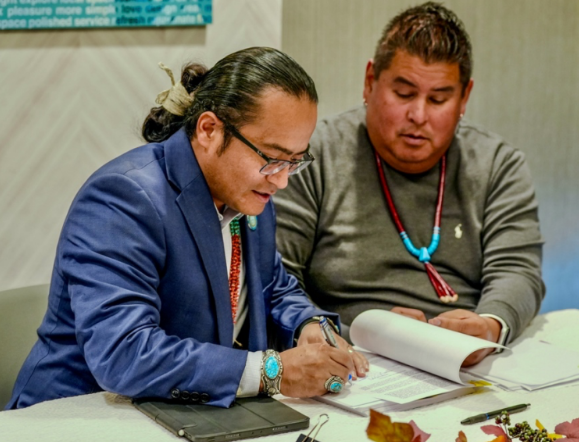
- Details
- By Native News Online Staff
A transformative step toward efficiency and modernization took place Friday as Navajo Nation President Buu Nygren signed a $31 million contract to implement an Enterprise Resource Planning (ERP) system.
“This is a historic moment for the Navajo Nation and Indian Country,” President Nygren said. “To meet the demands of a global world, our government must embrace modern technology to improve efficiency, transparency, and effectiveness.”
Powered by Arctic IT and Microsoft Dynamics, the ERP system will replace outdated, fragmented processes by consolidating data, eliminating excessive paperwork, and streamlining operations in key areas such as finance, human resources, and tribal census management.
A Leap Into the Digital Era
Navajo Nation Controller Sean McCabe emphasized the significance of this change for a government serving more than 400,000 people and employing 4,000 staff members.
“This modernization is about enhancing internal operations and delivering better services,” McCabe said. “After 20 years of patchwork systems, it’s time for an overhaul. ERP will make accounting and payments significantly faster and more efficient.”
McCabe described the system’s capacity to track payments and personnel actions with ease, cutting through long-standing bureaucratic delays.
“This is a shift from quantity to quality,” he said. “By letting the system handle routine tasks, our employees can focus on more meaningful work. And by reducing consulting fees, we expect to save millions annually.”
Overcoming Decades of Inefficiency
For decades, slow and cumbersome processes delayed vendor payments and hiring. The ERP system is designed to address these inefficiencies.
“We’ve had critical priorities delayed because funds weren’t flowing correctly,” McCabe said. “This system changes that, paving the way for quicker decisions and actions.”
Transforming Human Resources and Enrollment
Reycita Toddy, director of the Navajo Division of Human Resources, sees the ERP system as a solution to long-standing inefficiencies in hiring.
“For years, we aimed to go paperless, but we kept falling back on manual processes,” Toddy said. “With this system, we’ll speed up hiring and reduce errors in personnel forms.”
A primary goal is to fill vacant tribal positions, improving service delivery to tribal members. Additionally, ERP will support tribal census enrollment, particularly for members living off-reservation.
“This system will streamline verification and enrollment for urban members,” Toddy said. “It’s about serving the community more efficiently.”
A Unified Vision for Modernization
President Nygren attributed the success of the ERP initiative to collaboration among Navajo leadership and departments, including Human Resources, Navajo Information Technology, and the Office of Management and Budget.
“This is a project for the future,” Nygren said. “It’s about leaving our government stronger than we found it.”
The system will provide tribal leaders with real-time insights into project statuses, payments, and approvals, promoting transparency and accountability while reducing delays.
A Secure and Unified System
IT Manager Tracy Shorty, who will oversee the ERP implementation, highlighted its potential to unify and protect critical data.
“This system creates a central, secure hub for all operations,” Shorty said. “It’s a significant advancement for the Nation.”
Arctic IT, a Native-owned technology firm, expressed pride in partnering with the Navajo Nation on this groundbreaking initiative.
“This is more than a technology upgrade,” said Matt Borkowski, Arctic IT’s director of business applications. “It’s about empowering people to focus on impactful work by reducing administrative burdens.”
Looking Ahead
The ERP system will be rolled out in phases over the next year, with optimism from leaders and staff about its potential to transform government operations.
“The stronger we operate, the better we serve our people,” Nygren said. “This investment will improve lives and expedite services.”
“This is just the beginning,” he added. “We’re building a government that meets the needs of today and prepares for tomorrow.”
More Stories Like This
Native News Weekly (August 25, 2024): D.C. BriefsUS Presidents in Their Own Words Concerning American Indians
Tlingit & Haida Launch New Foundation to Support Education, Wellness
Michigan Attorney General Opens Criminal Investigation into Indian Boarding Schools
Next on Native Bidaské: Julian Brave NoiseCat on the Lumbee Nation’s 140-Year Fight for Federal Recognition
Help us defend tribal sovereignty.
At Native News Online, our mission is rooted in telling the stories that strengthen sovereignty and uplift Indigenous voices — not just at year’s end, but every single day.
Because of your generosity last year, we were able to keep our reporters on the ground in tribal communities, at national gatherings and in the halls of Congress — covering the issues that matter most to Indian Country: sovereignty, culture, education, health and economic opportunity.
That support sustained us through a tough year in 2025. Now, as we look to the year ahead, we need your help right now to ensure warrior journalism remains strong — reporting that defends tribal sovereignty, amplifies Native truth, and holds power accountable.
 The stakes couldn't be higher. Your support keeps Native voices heard, Native stories told and Native sovereignty defended.
The stakes couldn't be higher. Your support keeps Native voices heard, Native stories told and Native sovereignty defended.
Stand with Warrior Journalism today.
Levi Rickert (Potawatomi), Editor & Publisher


